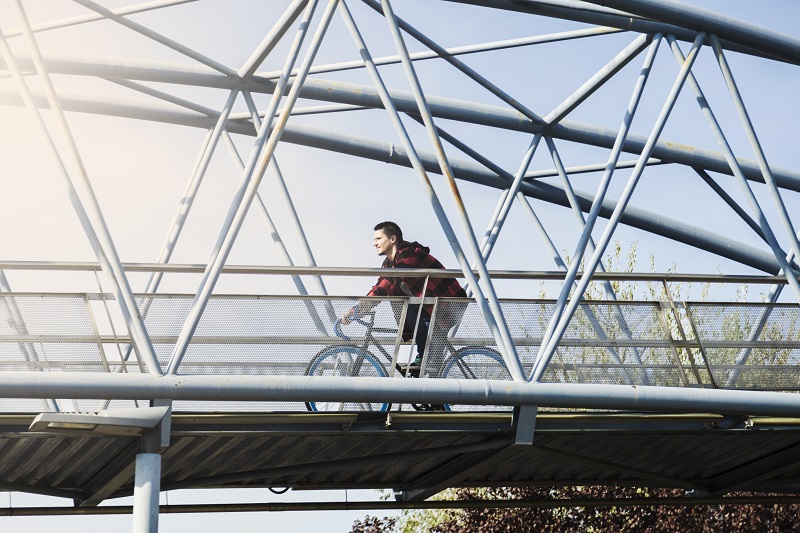
Three reasons to integrate cycling into the TEN-T network
For over twenty years the Trans-European Transport Network (TEN-T) has been a cornerstone of EU transport policy. It should come as no surprise therefore that ECF has been pushing hard to get the tectonic plates of European policy moving on this issue, to make sure that the needs of cyclists are integrated into the project. We are glad to see that some of our work has paid off, and that the newest commission proposal takes several steps in the right direction, heading towards setting cycling on a level playing field with other modes of transport when building infrastructure. ECF however thinks the EU needs to go further (our positon here), as the current low level of priority given to cycling infrastructure is fast becoming out of touch with the mobility needs of European citizens, for three clear reasons.
- E-bikes. This new cycling technology has been game changing for mobility. Electric bicycles allow cyclists to go further, increasing the range at which people choose to cycle from 7km on a regular bike, to 15km on an e-bike; go faster, as the battery will support a cyclist’s pedal power up to 25km/h; and go easier, since hills, the eternal adversary of the cyclist, can be climbed almost effortlessly, decreasing the ability requirements for crossing previously prohibitive geographic obstacles.
These elements, together with exponentially increasing sales figures (the number of e-bikes sold in the EU per year almost doubled in 4 years, from 854,000 in 2012 to 1.667 million in 2016), really means that the scope of cycling infrastructure can no longer be limited only to core urban areas and cycle tourism. Cycling infrastructure needs to be a real consideration in city suburbs and the countryside, so that large numbers of people can use their (e)bike in their everyday lives.
Source: CONEBI – Confederation of the European Bicycle Industry (2017)
- Cycle highways. This type of infrastructure is the gold standard of cycling route networks, and is designed to form the backbone of a regional cycling network, improving connectivity, allowing cyclists to travel at faster speeds than on normal cycle lanes, and separating cycle traffic from pedestrian and motorised vehicles. These increase the possible range of bicycles and make cyclists safer, and are often targeted at commuters who wish to travel from the suburbs and countryside into a city on a daily basis. Normally these people might have to use their car for such a journey, but with a cycle highway cycling becomes a safe, healthy and environmentally friendly option. Cycle highways thus fit perfectly into the goals of the TEN-T network, as they provide another modal layer to the network, which with the right infrastructure and planning can strongly complement other transportation methods.
- The impacts on cycling of TEN-T projects. As member states are increasing the amount of cycling infrastructure that they build, it is unfortunate to see that the impact of TEN-T projects on cycling can be rather hit and miss. I should start by saying, some projects have had strong positive effects, Muiderfietsbrug, near Amsterdam is an example.
Cycle bridge Muiderfietsbrug, built as part of a TEN-T reconstruction project.
In others however, engineers and project designers have shown a capacity to forget about cycling, rendering current cycling infrastructure unsafe or unusable. Szeged, Hungary, is a particularly poor example of this. Unfortunately, when the new M5 motorway was built outside the city, the highly used existing, cycle path into the nearby city was cut in half! This was not done because of ill-will from the project against cyclists, but simply as the project designers did not consider cycling adequately when the road was designed. Integrating cycling into the design process would ensure situations like this never happen again.
M5 Motorway, Szeged Hungary. The cycle path along road 55 was cut and not replaced.
Indeed the evidence is clear. Building cycling infrastructure is cheaper if it is done whilst building other projects. In many cases the majority of the cost of a project is adapting the cycling route to other existing infrastructure, with bridges or tunnels under/over a large road or railway. If cycling infrastructure was built at the same time as other projects, serious savings can be made, as the manpower, machinery and expertise are already onsite! It is therefore important that the EU starts to reap the benefits of this simple cost saving measure. Integrating cycling into to the TEN-T network is the place to start.
Photo credit: https://www.freepik.com/free-photos-vectors/travel, Travel image created by Freepik
Contact the author
Recent news!
Upcoming events
Contact Us
Avenue des Arts, 7-8
Postal address: Rue de la Charité, 22
1210 Brussels, Belgium









